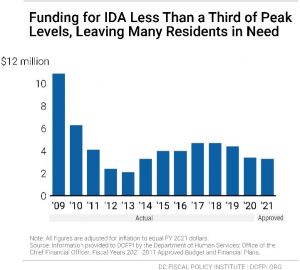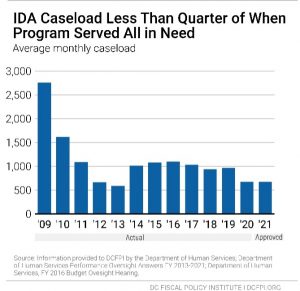Chairperson Nadeau and members of the Committee, thank you for the opportunity to testify today. My name is Kate Coventry and I am a senior policy analyst at the DC Fiscal Policy Institute (DCFPI). DCFPI is a nonprofit organization that promotes budget choices to reduce economic and racial inequality and build widespread prosperity in the District of Columbia through independent research and thoughtful policy recommendations.
I am here today to testify on how the Council needs to increase the level of investment in permanent housing, Project Reconnect, the Emergency Rental Assistance Program (ERAP), and the Interim Disability Assistance (IDA) program.
The Mayor’s Budget Invests in Permanent Housing, But Much More is Needed
Housing is healthcare. Every day individuals experiencing homelessness die from preventable and manageable diseases. Now during the pandemic, the connection between housing and healthcare is even more evident when one of the keys to staying healthy is staying at home. This is particularly true for residents who are chronically homeless, meaning they have been homeless for years and suffer from life-threatening health conditions and/or severe mental illness.
DCFPI envisions a future where no one is chronically homeless and no one dies without the dignity of a home. The fiscal year (FY) 2022 budget is a tool to make this vision a reality but only if the Council makes bold investments that build upon what is included in the proposed budget.
The proposed budget combines Emergency Housing Vouchers funded in the American Rescue Plan (ARP) and Fiscal Recovery Funds to provide Permanent Supportive Housing (PSH). The District will receive $11.7 million in voucher funding. While the U.S. Department of Housing and Urban Development (HUD) estimates this will translate into 707 vouchers, the DC Housing Authority (DCHA) estimates that it will create just 500 vouchers because of DC’s high rents. DCHA has asked HUD for additional funding to increase the number of vouchers. The following chart outlines the potential scenarios.
While this is a significant investment in individual PSH, it meets just 22 to 27 percent of the 2,761 slots needed. And very troubling, the upper range just meets what was funded in FY 2020, the year in which DC dedicated the most resources ever for individuals—138 site-based units and 615 vouchers, for a total of 753 slots. The Council should invest $54.7 to $59.1 million more to meet the full need.
The family PSH investment meets 69 to 80 percent of the need of 432 slots and falls far short of the 464 vouchers and 20 site-based units funded in FY 2019, the year in which DC dedicated the most resources ever for families. The Council should invest $4.9 to $6.8 million to meet the full need.
There is no new funding for Targeted Affordable Housing (TAH, which combines a tenant voucher with light touch services. We requested 928 new slots and none were funded. The Council should invest $23.34 million to meet this need.
The Mayor’s Budget Underfunds Project Reconnect; the Council Should Double It
The proposed FY 2022 budget for Project Reconnect is $325,000 lower than last year. Project Reconnect helps individuals who are newly homeless find alternatives to shelter such as reuniting with friends and families. Shelter can be traumatic and unsafe; avoiding shelter can benefit individuals.[1] Additionally because of budget limitations, only about 1 in 10 homeless individuals receive housing assistance in any given year, which means that shared housing may be the best option for an individual. Given that the end of the eviction moratorium will likely lead to an increase in the number of people experiencing homelessness or on the verge of homelessness, the Council should invest $1.375 million, doubling the budget and the number of individuals who can be served.
The Mayor’s Budget Invests Less in the Emergency Rental Assistance Program Relative to Last Year; the Council Should Level Fund It
The proposed Emergency Rental Assistance Program (ERAP) budget is $8.5 million. The FY 2021 budget was $14 million and included $5.5 million in one-time funds. The proposed budget did not replace this one-time funding. ERAP helps residents facing eviction pay for overdue rent and related legal costs. The program also provides security deposits and first month’s rent for residents moving into new homes. DHS reports that they believe the $352 million in federal eviction prevention funding in the STAY DC (Stronger Together by Assisting You) program will reach most of those in in need, reducing the need for ERAP. DCFPI and other advocates worry that not all residents will qualify for STAY DC, such as those who have rental arrears from more than a year ago or those who need more than 18 months of total assistance. DCFPI urges the Council to add at least $5.5 million to bring funding up to the FY 2021 level and increase funding to meet any need for eviction prevention or security deposits that will not be met by STAY DC.
The Mayor’s Budget Makes Modest Investments on Youth Homelessness, the Council Should Do More
Many youths experience homelessness without their parents or guardians and do not have children of their own. These “unaccompanied” homeless youth fall into two broad categories: those under age 18 and those who are 18 to 24 years old. In DC, youth under age 18 can only access housing and shelter dedicated to this population. Older youth, often called transition-aged youth (TAY), can access both TAY programs and adult housing and shelter.
The proposed budget modestly invests in youth homelessness, with just $53,920 for 10 PSH slots for youth aging out of the adult system. Youth with high needs who age out of the youth system and become homeless again must compete with highly vulnerable adults, who are older and have more severe medical needs for limited PSH slots. This pilot will allow the youth system to explore how to best transition high need young people from the youth system into the adult system.
The proposed budget dedicates $1.3 million in one-time funding to keep 50 shelter beds for transition aged youth (TAY), youth aged 18 to 24, open through FY 2022, thus meeting last year’s level. The budget also includes 1.5 million in Fiscal Recovery Funds to right size the budget for Extended Transitional Housing.
The budget unwisely removes $307,000 from various youth homelessness line items to fund the Rise Program, a new trauma therapy program for youth up to age 24. While advocates and providers agree this service is needed, it should not be funded by reducing existing homelessness programs. The Council should restore this funding.
The budget lacks funding for several key investments and the Council should fund the following:
- $75,000 in one-time funds for a cost analysis on the true costs of providing youth programs. Funding levels across youth programs vary greatly depending on the provider. This creates inconsistency in the quality and depth of services provided. An external cost analysis will help DHS and service providers create an ideal program model and budget accordingly;
- $574,000 in workforce programming for homeless youth. In FY 2021, the Department of Employment Services (DOES) cut this amount from their year-round youth employment program. By restoring this cut with local funds and specifically targeting these resources to homeless youth, the District can increase the number of homeless youth earning living wage jobs they need to afford housing;
- $70,000 for professional development so agencies can hire youth who have experienced homelessness. Many youth who have experienced homelessness would like to work in the field to help others who are experiencing homelessness but most providers lack funding for training. This investment would pay for a series of year-long trainings that prospective staff at any provider could attend;
- $558,000 to create a mobile behavioral health team that can meet youth where they are. Timely access to prescriptions and regular participation in therapy can be challenging for homeless youth who often lack funds for transportation and must wait for months for appointments. A mobile behavioral unit can visit youth sites to ensure easier and regular access; and
- $350,000 for a mentoring program pilot for 70 homeless youth. This is a request from youth experiencing homelessness. Access to mentors and supportive adults is critical to long-term success, but homeless youth face unique barriers to cultivating these kinds of connections.
Interim Disability Assistance (IDA) Not Reaching All Who Need It
IDA serves as a vital lifeline for DC residents with disabilities who cannot work and have no other income or other means to support themselves. It provides modest, temporary cash benefits to adults who have applied for federal disability benefits (Supplemental Security Income (SSI) or Social Security Disability Insurance (SSDI)) and are awaiting an eligibility determination. The wait time for federal benefit determination has skyrocketed in recent years, from 350 days in 2012 to nearly 600 days in 2017, leaving residents both unable to work and lacking benefits.[2]

IDA allows recipients to pay for basic needs such as transportation, medicine, toiletries, and food. In addition, the steady modest monthly income allows recipients to access some housing programs that are administered by nonprofit organizations and require residents to have some kind of income.
IDA is paid for with a combination of local funding, reimbursement from the federal government, and funds from the SSI Payback Fund. When an individual is approved for SSI, the federal government reimburses the District for the IDA benefits the individual received. These reimbursement dollars are used to support the annual budget, and unspent funds are put into the SSI Payback Fund at the end of the year so that the District can provide benefits for future IDA applicants.

The total proposed FY 2022 budget for IDA is $3.3 million, combining $2.5 million in local funds with $800,000 in federal reimbursements. This is less than one-third of the program’s FY 2009 peak funding level of $10.9 million and $1 million less in local funds than were allocated in FY 2019 (Figure 1).
In 2009 when IDA served all residents in need, it reached around 2,750 residents per month. Because of its limited budget, only 673 people per month receive benefits in FY 2021 (Figure 2). DCFPI estimates that the same number of residents need benefits today as in 2009. DCFPI recommends that the Council double the IDA caseload to 1,346 in FY 2022 with a $3.3 million investment, with the goal of expanding the program to serve all in need within 5 years.
Thank you for the chance to submit this testimony.
[1] “Diversion,” National Alliance to End Homelessness, August 10, 2010, https://endhomelessness.org/resource/diversionexplainer/
[2] “597 Days and Still Waiting.” Terrence McCoy. The Washington Post. 11 Nov. 2017. http://www.washingtonpost.com/sf/local/2017/11/20/10000-people-died-waiting-for-a-disability-decision-in-the-past-year-will-he-be-next/

